If you’ve just completed your DIY electric guitar build, you might assume the hardest part is over. But before you plug in and shred, there’s one critical step you shouldn’t skip: intonation. Without it, even a beautifully wired, great-looking guitar can sound… off. This guide will walk you through how to properly set up your electric guitar kit for intonation, ensuring your notes ring true across the fretboard.

Understanding Intonation: The Heartbeat of Your Sound
Intonation refers to how accurately your guitar plays in tune all the way up the neck. Even if your open strings are perfectly tuned, poor intonation means chords and notes farther up the fretboard may sound sharp or flat.
** Here’s a little transparency: Our website contains affiliate links. This means if you click and make a purchase, we may receive a small commission. Don’t worry, there’s no extra cost to you. It’s a simple way you can support our mission to bring you quality content. **
As an Amazon Associate, I earn from qualifying purchases.
Why It Matters
Your tone can be affected by a dozen factors — wood type, pickup selection, nut material — but intonation is one of the most fundamental. For a deep dive into other tone factors, see:
- Effects Of Different Wood Types On Electric Guitar Tone
- How Pickup Position Affects Electric Guitar Tone In Kits
- How To Choose The Perfect Nut Material For Your Electric Guitar
Signs Your Intonation Needs Adjusting
- Chords that sound off even after tuning.
- Notes on the 12th fret that are sharp or flat compared to their harmonics.
- Tuning inconsistencies when fretting up the neck.
Intonation is a playability factor, not just a tonal one. To further improve your kit’s sound, also explore Playing With Tone Controls: Tips For Electric Guitar Kits and Adjusting Pickup Height For Optimal Sound On Your Guitar.
Tools and Preparation: Setting the Stage for Success
Before diving in, make sure you’ve got the right tools and workspace ready. Precision and patience are your best friends here.
Essential Tools
- Precision electronic tuner
- Small screwdriver (Phillips or flat-head depending on your saddles)
- New set of strings (intonation should never be done on old strings)
- Ruler or feeler gauge for checking string height
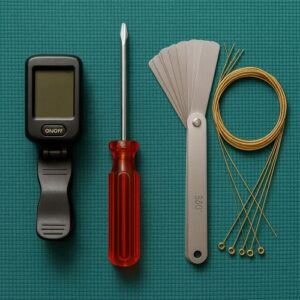
Not sure what gear you need for setup? Review both Essential Tools Every Electric Guitar Kit Builder Should Have and Tools Needed For Building An Electric Guitar Kit for full checklists.
Preparing Your Guitar Kit
- Install New Strings – Old strings give false intonation readings.
- Tune Accurately – Use a reliable tuner and get each string perfectly in pitch.
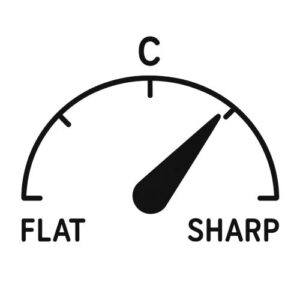
- Check the Action First – If the string height is way off, fix that before touching the saddles. (See Setting Up The Bridge And Neck On Your Electric Guitar Kit.)
- Safe, Distraction-Free Work Area – Set up on a padded, stable surface with good lighting.
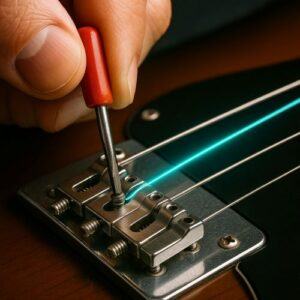
Bonus tip: If you’re still building or fine-tuning your kit, check out the Step-by-Step Guide To Building Your First Electric Guitar Kit.
Step-by-Step Guide to Electric Guitar Intonation
Let’s get into the nitty-gritty of intonation adjustments.
Step 1: Tune Up
Start by tuning each string to pitch using your electronic tuner.
Step 2: Compare the 12th Fret Harmonic and Fretted Note
- Play the 12th fret harmonic and note the pitch.
- Then fret the 12th fret and check again.
-
- If the fretted note is sharp, move the saddle away from the neck.
- If it’s flat, move the saddle toward the neck.
Step 3: Adjust and Re-Tune
Make small saddle adjustments using your screwdriver, re-tune, and recheck. Repeat as needed.
Step 4: Go String by String
You’ll need to go through this process for every string. It’s time-consuming, but accuracy here makes all the difference.
If things still sound off after this, revisit Troubleshooting Common Issues During Electric Guitar Kit Assembly.
Tackling the Saddle: Finding Your Sweet Spot
The saddle is where the fine-tuning magic happens.
Which Way to Move the Saddle?
- Flat fretted note = shorten string (move saddle forward)
- Sharp fretted note = lengthen string (move saddle back)
For detailed saddle setup, check your bridge type. If you’re not sure how to set it up, see Setting Up The Bridge And Neck On Your Electric Guitar Kit for model-specific guidance.
Saddle Adjustment Tips
- Always tune to pitch before comparing notes.
- Don’t force screws—go slow to avoid stripping or damaging hardware.
- Double-check all adjustments with your tuner.
Still not getting your desired sound? You may want to check your tone circuit with Using Tone Pots And Capacitors To Sculpt Your Sound.
Mastering Strat Intonation: A Special Note for Strat Users
Strat-style guitars come with their own intonation quirks. If your kit features a floating tremolo bridge, here’s what you need to know.
Unique Strat Challenges

- The tremolo system affects tuning stability.
- Vintage-style saddles are trickier to adjust.
- String spacing and staggered saddles require balancing.
Steps for Strat-Style Intonation
- Level the bridge so it sits parallel to the guitar body.
- Use the tuner to check 12th fret harmonic vs fretted notes.
- Adjust saddle screws carefully without tilting.
Strat vs Other Guitars
Strats are more sensitive to environmental changes and need regular checkups. But once dialed in, they offer exceptional tonal flexibility. To keep things tight, check out Guide To Wiring Your Electric Guitar Kit For Optimal Performance and Installing Pickups In Your Electric Guitar Kit: A Complete Guide.
Final Thoughts: Dialing in Your Kit the Right Way
Proper intonation turns your electric guitar kit from “good effort” to “gig-ready.” With just a few tools and the right method, your guitar will play in tune from open strings to the top fret. Don’t let poor intonation ruin a great build—make it the final step in turning your kit into a fully playable, professional instrument.
Still debating your next build? Read Budget Vs Premium Electric Guitar Kits: Which One To Choose? to help weigh your options. And if you’re looking to personalize your next kit, explore Customizing Your Electric Guitar Kit With Unique Fretboard Inlays.
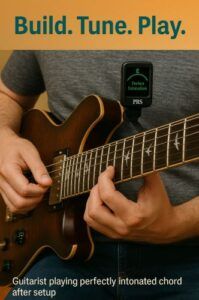
There are 100’s of ways you can build a business around your passion for guitar building.
Check it out…


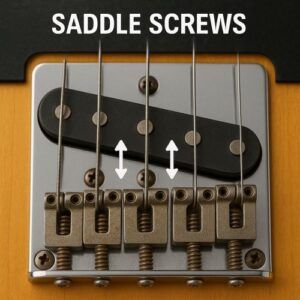

Hi Wayne!
Just finished reading your guide to tuning an electric guitar kit and really appreciated it.
As someone who has struggled with a slightly weird DIY build in the past, your detailed step-by-step breakdown was just what I needed.
You made a potentially daunting process seem completely approachable. The “12th harmonic fret vs. fretted note” tip? Brilliant—so practical! I also loved the Strat-specific tip; my last kit had a tremolo and I wish I had known about these quirks sooner. Your emphasis on fresh strings and your patience really struck a chord with me—I’ve definitely rushed this step before and paid the price in tuning headaches.
One thing that really struck me: you called the tone the “heartbeat” of the sound. So true! After my first build, I realized that even beautiful pickups can’t save a bad tone. It’s the invisible glue that holds everything together.
Any additional wisdom on vintage-style bridges with limited saddle travel? How often do you retune in very humid climates?
Thanks for such a clear and encouraging guide. You turned a technical chore into something rewarding. The neck of my next kit will sing because of it!
Best regards,
Mitia
Wow, thank you for such a thoughtful comment! It means a lot to hear that the guide helped you, especially since DIY kits can definitely throw some curveballs. That 12th fret harmonic trick is one of those little game-changers, right? And yeah, Strat-style tremolos can be deceptively finicky, I’ve learned that lesson the hard way too.
Great questions, by the way. With vintage-style bridges, I’ve found that dialing in intonation sometimes means finding a “happy medium” rather than perfect tuning across all strings, especially if saddle travel is limited. Sometimes flipping the saddle or using compensated saddles can help. As for humid climates, I usually do a quick check and retune every time I pick up the guitar. Humidity can wreak havoc, especially on neck relief and tuning stability.
Glad to hear your next kit’s neck will sing! That’s what it’s all about. Appreciate you taking the time to write in.
Keep building!
This is such a clear and encouraging guide—setting up proper intonation truly transforms a basic build into a guitar that plays in tune across the entire fretboard. I really appreciate how you break down the process starting with fresh strings, accurate tuning, and checking the action before adjusting saddles. The step-by-step comparison between the 12th-fret harmonic and the fretted note is both simple and profoundly effective. Calling intonation the “heartbeat of your sound” is such a powerful image—it underscores how crucial this step is, even more than flashy hardware or fancy pickups.
Your special notes for Strat-style bridges are especially helpful—floating bridges do introduce unique challenges, and your method for leveling the bridge and carefully adjusting saddles is exactly the practical advice builders need. For anyone building a DIY kit, your emphasis on patience, precision, and methodical tuning can’t be overstated—it turns an intimidating final step into a rewarding one.
If there’s one thing builders often underestimate, I’d guess it’s the value of starting with brand-new strings—old ones can mask intonation issues and lead to frustration down the line. What’s one small detail in the intonation process that tends to surprise beginners the most when they first try it?
Thank you so much! I’m glad the guide made intonation approachable! Getting it right really does transform a guitar from “just playable” to something that sings across the whole fretboard.
You’re spot on about new strings, they make a huge difference in accuracy and make the whole process less frustrating. One small detail that tends to surprise beginners is just how sensitive the saddles can be. Even tiny adjustments, fractions of a millimeter, can noticeably change the intonation, and it can be eye-opening to see how precise the process needs to be. Another common surprise is how much neck relief and action affect intonation; sometimes the problem isn’t the saddles at all, but small tweaks to the neck or string height can make everything fall into place.
It’s always rewarding to see builders gain confidence with these steps. It’s those little “aha” moments that really make the effort worthwhile!
Thanks again,
~Wayne
Great post, Wayne! Intonation is one of those often-overlooked steps that can make or break a DIY guitar build. You’ve broken it down in a way that’s both practical and encouraging, which is perfect for beginners who may feel intimidated by the process. I especially appreciate how you emphasized using fresh strings and tuning accuracy before adjusting saddles—many players skip that and wonder why their guitar never sounds quite right. The section on Strat-style guitars was a solid addition too, since floating tremolo setups can be a real headache if you don’t know what you’re doing. Overall, this guide does a fantastic job of showing that intonation isn’t just about tone—it’s about playability and making the guitar truly gig-ready. With patience, the right tools, and your step-by-step approach, any builder can bring their kit to life.
Thanks so much for the thoughtful comment! I’m glad the guide came across as practical and encouraging. Intonation really is one of those steps that can make a huge difference, and it’s easy to overlook. You’re spot-on about fresh strings and accurate tuning; skipping that step is a common pitfall. I’m also happy the Strat-style section hit the mark. Floating tremolos can definitely be tricky for DIY builders. Your feedback really reinforces why I love breaking these steps down for builders of all levels.
Thanks again for taking the time to read and share your thoughts!
~Wayne